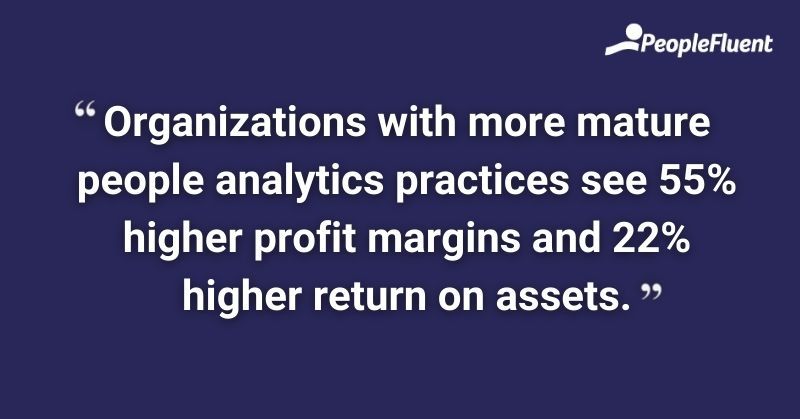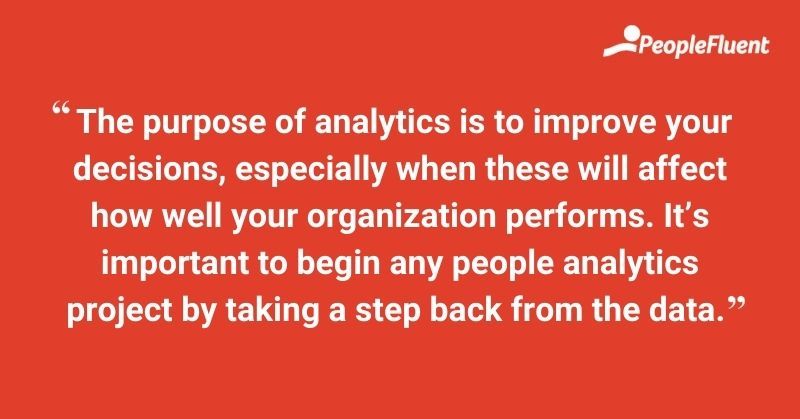Published: Sep 9, 2021Time to read: 5mins Category: Insights
Want to Focus Your People Analytics Strategy? Start With the End in Mind
The way we manage our people has never been more important for HR leaders. That’s why finding new ways to use data to influence our business decisions and strategies is crucial. One way is leveraging people analytics. The good news is you don’t need to be a statistician or programmer to nail it—in fact, getting started can be as simple as asking the right questions. Read the article to find out more.
A volatile and constantly changing business environment has created an urgent need for better people decisions everywhere. At the same time, the volume of workforce data continues to grow at an unprecedented rate. According to The World Economic Forum, by 2025, it’s estimated that 463 exabytes of data will be created each day globally—that’s 463 million trillion bytes or 463,000,000,000,000,000,000 bytes!
While having all this new information can lead you to better decisions, merely having data is not enough to succeed. To be truly successful, you must be able to interrogate your data to determine the root cause of problems, apply appropriate interventions, and anticipate future developments based on hard evidence. This process is at the heart of effective people analytics strategies.

Why Is People Analytics Important for Organizations?
The power of people analytics in everyday decision-making is undeniable:
- According to DDI, organizations that excel at people analytics are 3.1 times more likely to outperform their peers.
- Research from our analytics partner, Visier, shows that organizations with more mature people analytics practices see 55% higher profit margins and 22% higher return on assets.
YOU MIGHT ALSO LIKE | ‘Rapid Pace of Change: 3 Ways HR Teams Can Prioritize Data Security’
What Is People Analytics?
People analytics (also called HR analytics or workforce analytics) is the practice of collecting and transforming HR data and organizational data into actionable insights that improve the way you do business. It’s a tech agnostic discipline, which means that there’s no one-size-fits-all approach that solves every client’s every problem and refers to all the business data that applies to employees and contingent workers.
By transforming raw data into meaningful insights, answers, and solutions, people analytics provides organizations the ability to better understand their workforce and organization. Through the insights gathered, HR leaders can also back up their instincts with facts and rely on data-driven strategies that help their organization grow.
If people analytics seems like a daunting undertaking, know that it is possible to adopt a more scientific approach to data analysis—even if you don’t have deep statistical expertise, programming skills, or an understanding of advanced mathematical techniques.
Advances in cloud and analytics technology have led to the development of people analytics solutions that are possible to achieve without a data scientist’s help. Using this type of solution, you’ll be able to take advantage of your data to optimize your employee experience and create the best organizational structure to maximize productivity.
RELATED READING | ‘Employee Experience: How to Manage Before Day One… and Beyond’
Here’s the first step in determining your people analytics strategy:

Get Started By Defining the Questions
The purpose of analytics is to improve your decisions, especially when these will affect how well your organization performs. Therefore, it’s important to begin any people analytics project by taking a step back from the data. You want to start with the end in mind, which means determining how your people decisions can have a positive impact on the rest of the business.
To do this, follow these simple steps:
First, identify the key business objectives for the long- and short-term, such as growing the bottom line or maintaining productivity during a merger. Then, clearly define the questions you want to answer that support your objectives.
For example, growing the bottom line can mean asking questions such as:
- Are we aligning pay with performance?
- Are changes in compensation relevant to changes in organizations and employee-level performance?
- Are we building a talent pipeline through decisions that align with performance and potential?
When the end-goal is clearly defined, you’re better able to focus your analysis, refine programs to optimize spend and hone in on areas that will have a measurable impact on the business.
When formulating your questions, don’t just focus on the workforce. You should also dive into the strategic questions that will improve business outcomes. A business-oriented mindset will not only help you focus on the right issues and opportunities, it’ll also help in choosing the right people analytics solution, streamline implementation, and support your business case by demonstrating how investing in people analytics solves key business problems.
Examples of Core Workforce Questions to Ask
Here are some key questions to ask:
- How many people are there?
- How many people are needed?
- Are people leaving at a high or low rate?
- Is the capacity for work enough for the work required?
- What is the overall cost to hire, retain, or develop people?
- Is the total cost of the workforce increasing quickly or slowly?
- How well are avoidable costs, such as absences or labor relations issues, being controlled?
Other Considerations When Formulating Questions
You should also try to think about the following:
- Understand the core demographics of your organization and track changes by tenure, age, job name, manager, and starts vs. exits, among others.
- Monitor and reduce turnover through analyzing employee exit patterns.
- Do you have the right spans and layers in your organization? Consider Manager Ratios, Span of Control, and Organizational Levels.
- In terms of diversity, equity, and inclusion, how can your organization eliminate bias and employ equitable hiring practices?
HANDPICKED FOR YOU | ‘4 Key Components of Building a Data-Driven DEI Strategy’

Step 1 Is Done! What Now? Continue Reading...
This blog post has been adapted from our ebook, ‘5 Steps to Getting Started With People Analytics’. Now that you’re familiar with the first step to successfully implementing people analytics, it’s time to download your copy to discover the other four steps to effectively leverage people analytics in improving and shaping your people strategies.